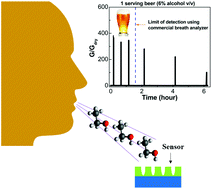Nanostructuring mechanical cracks in a flexible conducting polymer thin film for ultra-sensitive vapor sensing†
Abstract
The swelling of electrically conducting polymer films upon absorption of vapors like alcohol or moisture is widely known. However, this swelling leads to feeble changes in charge transport characteristics. We demonstrate a colossal enhancement (from ∼6% to 108%) in the vapor-induced resistance change for a representative system, poly(3,4-ethylene dioxythiophene) polystyrene sulfonate (PEDOT:PSS). This is achieved when the films are nanostructured by strain-induced quasi-periodic parallel cracks, which is then followed by crack engineering. The cracks are nanostructured such that the charge carrier percolation pathways are nearly turned off in the absence of alcohol vapor or at low humidity. These percolation pathways are restored upon alcohol vapor or humidity exposure. When used as an alcohol sensor, this system shows ultra-high sensitivity of 106 for methanol vapors, when compared to ethanol vapors (2 × 102). When used as a humidity sensor in the range 60–100% RH, a resistance ratio of 1.5 × 102 is realized. The different extent of response to alcohol vapors and humidity is attributed to the dominance of the surface ionic conduction process in the former. These sensing characteristics are achieved with short response and recovery time (<5 s). The developed sensing platform outperforms commercial portable breath analyzers. While cracks have been utilized for developing ingenious strain sensors in the literature, here we demonstrate an approach based on the same that substantially amplifies vapor response.



 Please wait while we load your content...
Please wait while we load your content...